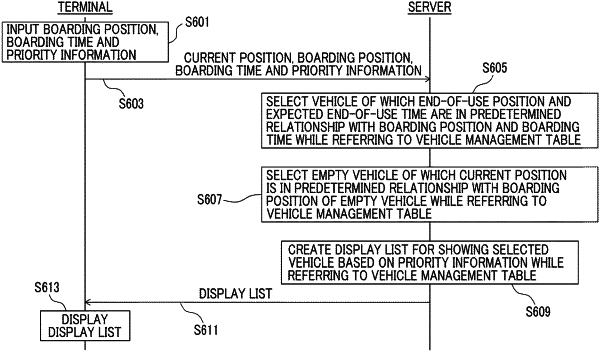| CPC G06Q 50/40 (2024.01) [G05D 1/0088 (2013.01)] | 20 Claims |

|
1. A vehicle information processing system comprising:
a plurality of vehicles; and
a vehicle information processing apparatus comprising:
a processor configured to:
acquire a boarding position and a boarding time at which a first user wants to get on a vehicle,
select at least one vehicle, of which an end-of-use position and an expected end-of-use time, at which a second user of a vehicle ends use of the vehicle for each of the plurality of vehicles, are in a predetermined relationship with the boarding position and the boarding time, from among the plurality of vehicles,
transmit, to a terminal, information on the at least one vehicle selected by the processor and information on the end-of-use position and the expected end-of-use time of each of the at least one vehicle,
cause the terminal to display the information transmitted to the terminal,
receive information on a vehicle selected by the first user from among the at least one vehicle,
transmit a standby request to request the vehicle selected by the first user to standby at the end-of-use position at which the second user ends use of the vehicle until the first user gets on the vehicle selected by the first user,
when it is not possible to select a vehicle of which the end-of-use position is separated from the boarding position by a distance shorter than a first distance, select at least one vehicle of which the end-of-use position is separated from the boarding position by a distance shorter than a second distance, the second distance greater than the first distance, and
when it is not possible to select a vehicle of which the expected end-of-use time is different from the boarding time by a time shorter than a first time, select at least one vehicle of which the expected end-of-use time is different from the boarding time by a time shorter than a second time, the second time greater than the first time,
wherein when the vehicle receives the standby request, the vehicle is autonomously controlled to standby at the end-of-use position at which the second user ends use of the vehicle until the first user gets on the vehicle.
|